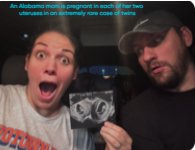A home pregnancy test revealed a positive result, prompting Elsa to share the delightful news with her husband, Caleb, who has consistently been her unwavering source of support. Together, as residents of Dora, Alabama, the Hatchers joyfully embraced the news.
Around eight weeks into her pregnancy, during the initial ultrasound appointment, Elsa Artunez Hatcher experienced an unforeseen turn of events.

While Elsa cradles her newborn daughter, Yesenia Patricia, born in an unconventional delivery room—transformed from a parking garage—the story unfolds. During the initial ultrasound appointment, the technician promptly identified the first baby, providing reassurance to Hatcher that everything looked perfect, and the baby was in good health.
It was precisely at this juncture that Hatcher recalled her distinctive anatomy—a condition referred to as uterine didelphys, wherein she possesses two uteruses. Offering a gentle reminder to the technician, she explained her unique situation

“Should you be scanning and happen to catch a glimpse of it or something, don’t assume it’s just a random occurrence or that there’s something wrong. There is a completely separate uterus there,” elucidated the 32-year-old Hatcher.
Appreciative of the advance notice, the ultrasound technician expressed gratitude and opted to swiftly inspect the second uterus to ensure everything was proceeding smoothly. As the technician guided the ultrasound wand to the opposite side of Elsa’s belly, Hatcher couldn’t contain her surprise, exclaiming, “Oh, my gosh! There’s another one.”

Hatcher’s condition is, indeed, a rarity, affecting approximately 1 in 2,000 women, identified as uterine didelphys. The unforeseen narrative of fraternal twins, Noah and Rosalie, took shape when Rosalie joined Baby Noah in utero approximately three weeks after Noah’s conception.
The distinctive element of Hatcher’s pregnancy lies in the simultaneous conception in both uteruses, requiring the fertilization of two eggs—one in each uterus. Much like the majority of women, Hatcher possesses two ovaries, the vital reproductive organs responsible for storing and releasing eggs. Each ovary is intricately connected to a separate uterus. Typically, ovaries follow a pattern of releasing eggs alternately, dispatching one into the uterus during each cycle for potential fertilization. However, on occasion, an ovary may release more than one egg during a cycle—a phenomenon known as hyperovulation.

While investigations into hyperovulation are limited, a 2006 study involving 500 women suggested that about 1 in 5 women had the capacity for hyperovulation. It’s important to note that this phenomenon doesn’t manifest in every menstrual cycle. During hyperovulation, a single ovary may, in some instances, release two eggs. Even more seldom, both ovaries may simultaneously release a single egg, as observed in Hatcher’s case.
As per case studies, the likelihood of a woman with two uteruses becoming pregnant with a baby in each uterus simultaneously is estimated to be approximately 1 in 2 billion in the general population. Nevertheless, due to the extreme rarity of such instances, determining the precise probability remains challenging.
The exceptional rarity of this pregnancy imbues Elsa Hatcher’s experience with a profound and meaningful depth.

“There’s an unmistakable sense of miracle in these babies, and the realization that they are destined for something extraordinary. The perfect alignment of all these factors, the way it unfolded—there’s no room for questioning. It’s a testament to something greater,” expresses Hatcher, underscoring the profound significance that this unique pregnancy holds for her and her family.
